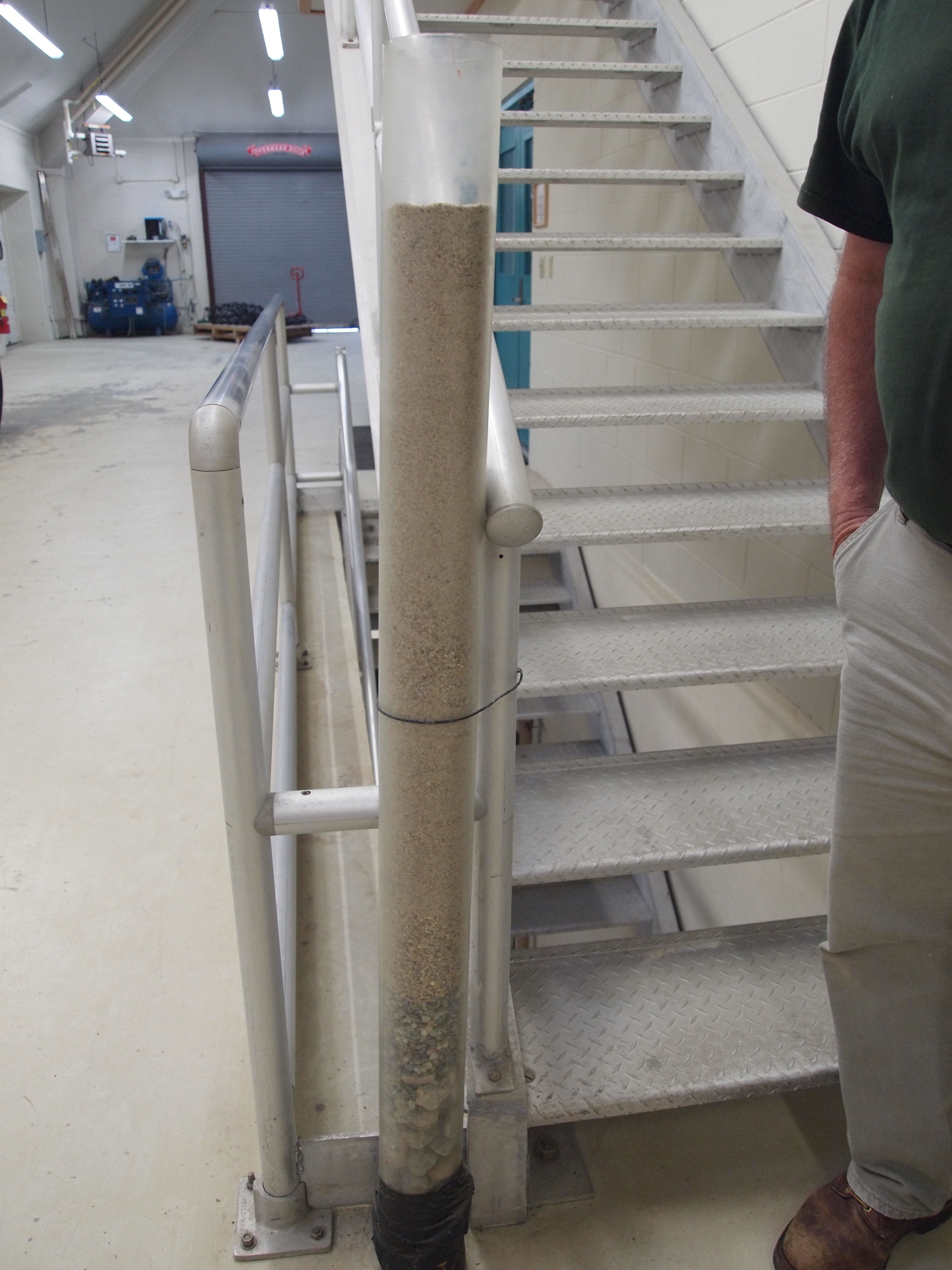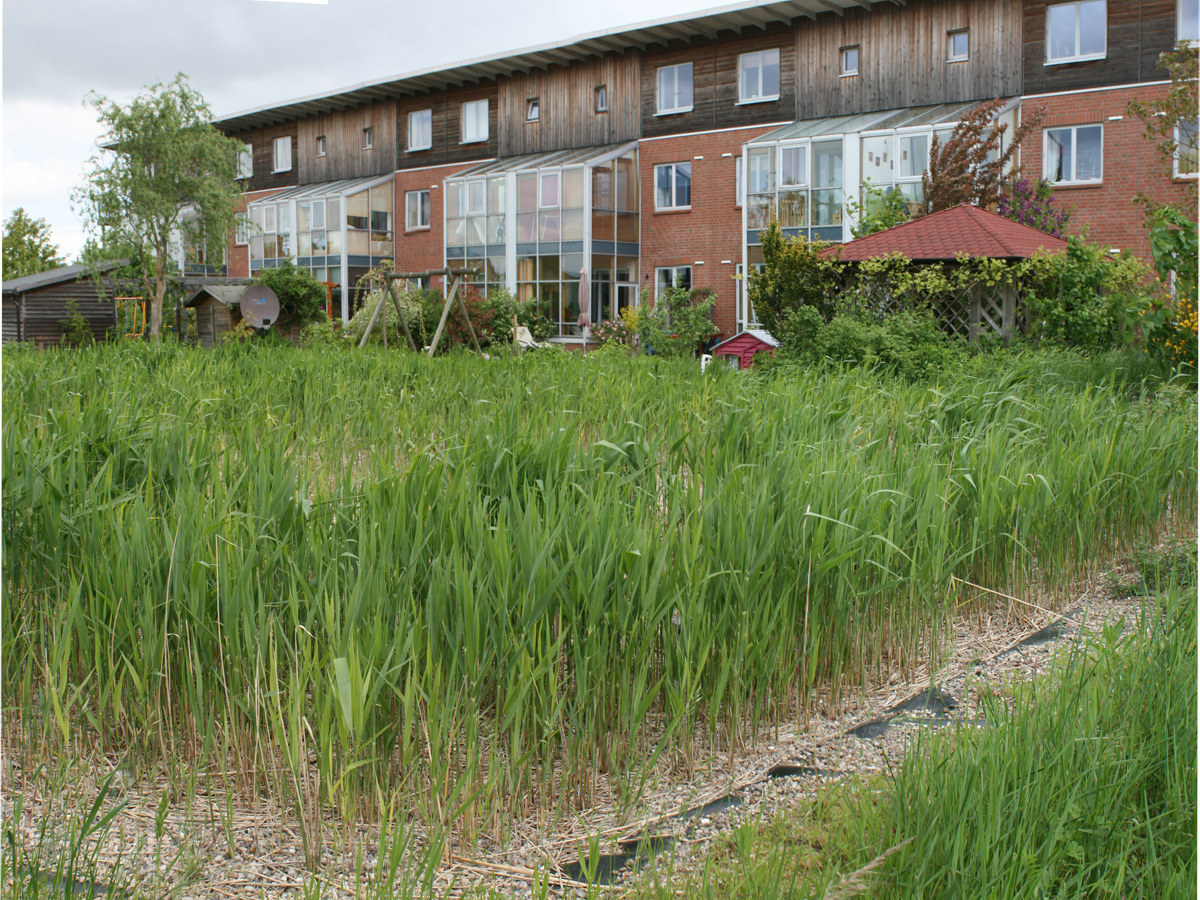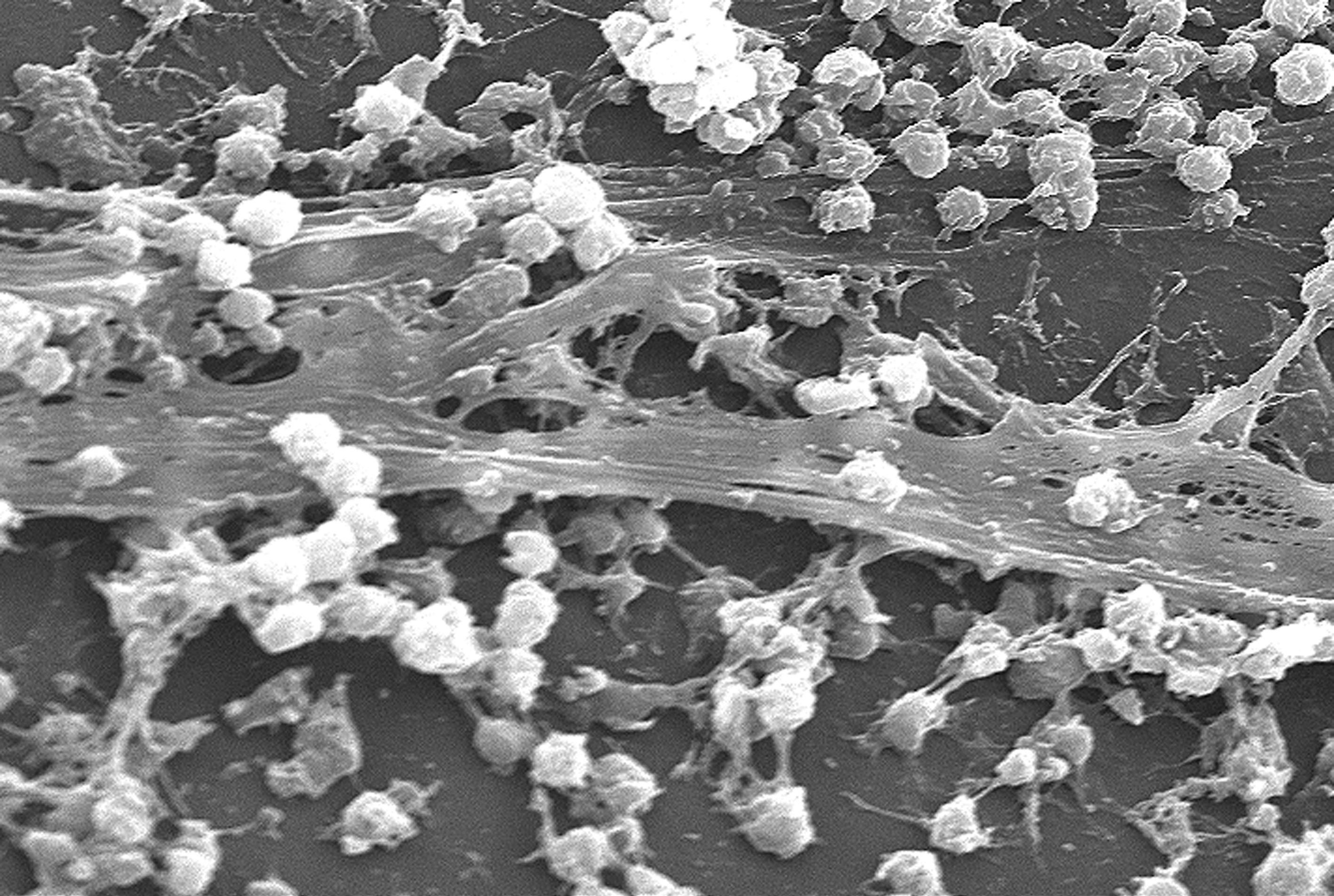|
Bioclogging
Bioclogging or biological clogging refers to the blockage of pore space in soil by microbial biomass, including active cells and their byproducts such as extracellular polymeric substance (EPS). The microbial biomass obstructs pore spaces, creating an impermeable layer in the soil and significantly reducing water infiltration rates. Bioclogging occurs under continuous ponded infiltration at various field conditions such as artificial recharge ponds, percolation trenches, irrigation channels, sewage treatment systems, constructed wetlands, landfill liners and natural systems such as riverbeds and soils. It also affects groundwater flow in the aquifer, such as ground source heat pumps, permeable reactive barriers, and microbial enhanced oil recovery. Bioclogging is a significant problem where water infiltration is hampered and countermeasures such as regular drying of the system can reduce the levels of bioclogging. However, bioclogging can also serve beneficial purposes in spe ... [...More Info...] [...Related Items...] OR: [Wikipedia] [Google] [Baidu] |
Microbial Enhanced Oil Recovery
Microbial Enhanced Oil Recovery (MEOR) is a biological-based technology involving the manipulation of functions or structures within microbial environments present in oil reservoirs. The primary objective of MEOR is to improve the extraction of oil confined within porous media, while boosting economic benefits.Lazar, I., I.G. Petrisor, and T.E. Yen, Microbial enhanced oil recovery (MEOR). Petroleum Science and Technology, 2007. 25(11–12): p. 1353-1366Ollivier, B. and M. Magot, eds. Petroleum microbiology. 1st ed. 2005, ASM Press: Washington, DC. 365Sen, R., Biotechnology in petroleum recovery: The microbial EOR. Progress in Energy and Combustion Science, 2008. 34(6): p. 714-724Van Hamme, J.D., A. Singh, and O.P. Ward, Petroleum microbiology – Part 1: Underlying biochemistry and physiology. Chimica Oggi-Chemistry Today, 2006. 24(1): p. 52Fujiwara, K., et al., Biotechnological approach for development of microbial enhanced oil recovery technique. Petroleum Biotechnology: Developm ... [...More Info...] [...Related Items...] OR: [Wikipedia] [Google] [Baidu] |
Slow Sand Filter
Slow sand filters are used in water purification for treating raw water to produce a potable product. They are typically deep, can be rectangular or cylindrical in cross section and are used primarily to treat surface water. The length and breadth of the tanks are determined by the flow rate desired for the filters, which typically have a loading rate of per square metre per hour. Slow sand filters differ from all other filters used to treat drinking water in that they work by using a complex biofilm that grows naturally on the surface of the sand. The sand itself does not perform any filtration function but simply acts as a substrate, unlike its counterparts for ultraviolet and pressurized treatments. Although they are often preferred technology in many developing countries because of their low energy requirements and robust performance, they are also used to treat water in some developed countries, such as the UK, where they are used to treat water supplied to London. Slow ... [...More Info...] [...Related Items...] OR: [Wikipedia] [Google] [Baidu] |
Septic Tank
A septic tank is an underground chamber made of concrete, fiberglass, or plastic through which domestic wastewater (sewage) flows for basic sewage treatment. Settling and anaerobic digestion processes reduce solids and organics, but the treatment efficiency is only moderate (referred to as "primary treatment"). Septic tank systems are a type of simple onsite sewage facility. They can be used in areas that are not connected to a sewerage system, such as rural areas. The treated liquid effluent is commonly disposed in a septic drain field, which provides further treatment. Nonetheless, groundwater pollution may occur and is a problem. The term "septic" refers to the Anaerobic digestion, anaerobic bacterial environment that develops in the tank that decomposes or mineralizes the waste discharged into the tank. Septic tanks can be coupled with other Onsite sewage facility, onsite wastewater treatment units such as biofilters or aerobic systems involving artificially forced aeration. T ... [...More Info...] [...Related Items...] OR: [Wikipedia] [Google] [Baidu] |
Septic Drain Field
Septic drain fields, also called leach fields or leach drains, are subsurface wastewater disposal facilities used to remove contaminants and impurities from the liquid that emerges after anaerobic digestion in a septic tank. Organic materials in the liquid are catabolized by a microbial ecosystem. A septic drain field, a septic tank, and associated piping compose a septic system. The drain field typically consists of an arrangement of trenches containing perforated pipes and porous material (often gravel) covered by a layer of soil to prevent animals (and surface runoff) from reaching the wastewater distributed within those trenches. Primary design considerations are both ''hydraulic'' for the volume of wastewater requiring disposal and ''catabolic'' for the long-term biochemical oxygen demand of that wastewater. The land area that is set aside for the septic drain field may be called a septic reserve area (SRA). Sewage farms similarly dispose of wastewater through a series ... [...More Info...] [...Related Items...] OR: [Wikipedia] [Google] [Baidu] |
Constructed Wetland
A constructed wetland is an artificial wetland to treat sewage, greywater, stormwater runoff or Industrial wastewater treatment, industrial wastewater. It may also be designed for land reclamation after mining, or as a Flood mitigation, mitigation step for natural areas lost to land development. Constructed wetlands are engineered systems that use the natural functions of vegetation, soil, and organisms to provide secondary treatment to wastewater. The design of the constructed wetland has to be adjusted according to the type of wastewater to be treated. Constructed wetlands have been used in both centralized and decentralized wastewater systems. Primary treatment is recommended when there is a large amount of suspended solids or soluble organic matter (measured as biochemical oxygen demand and chemical oxygen demand). Similar to natural wetlands, constructed wetlands also act as a biofilter and/or can remove a range of pollutants (such as organic matter, Nutrient pollution, nutri ... [...More Info...] [...Related Items...] OR: [Wikipedia] [Google] [Baidu] |
Biofilm
A biofilm is a Syntrophy, syntrophic Microbial consortium, community of microorganisms in which cell (biology), cells cell adhesion, stick to each other and often also to a surface. These adherent cells become embedded within a slimy extracellular matrix that is composed of extracellular polymeric substances (EPSs). The cells within the biofilm produce the EPS components, which are typically a polymeric combination of extracellular polysaccharides, proteins, lipids and DNA. Because they have a three-dimensional structure and represent a community lifestyle for microorganisms, they have been metaphorically described as "cities for microbes". Biofilms may form on living (biotic) or non-living (abiotic) surfaces and can be common in natural, industrial, and hospital settings. They may constitute a microbiome or be a portion of it. The microbial cells growing in a biofilm are physiology, physiologically distinct from planktonic cells of the same organism, which, by contrast, ... [...More Info...] [...Related Items...] OR: [Wikipedia] [Google] [Baidu] |
Pore Space In Soil
The pore space of soil contains the liquid and gas phases of soil, i.e., everything but the solid phase that contains mainly minerals of varying sizes as well as organic compounds. In order to understand porosity better a series of equations have been used to express the quantitative interactions between the three phases of soil. Macropores or fractures play a major role in infiltration rates in many soils as well as preferential flow patterns, hydraulic conductivity and evapotranspiration. Cracks are also very influential in gas exchange, influencing respiration within soils. Modeling cracks therefore helps understand how these processes work and what the effects of changes in soil cracking such as compaction, can have on these processes. The pore space of soil may contain the habitat of plants (rhizosphere) and microorganisms. Background Dry bulk density : \rho_ = \frac The dry bulk density of a soil greatly depends on the mineral assemblage making up the soil and on ... [...More Info...] [...Related Items...] OR: [Wikipedia] [Google] [Baidu] |
Algae
Algae ( , ; : alga ) is an informal term for any organisms of a large and diverse group of photosynthesis, photosynthetic organisms that are not plants, and includes species from multiple distinct clades. Such organisms range from unicellular microalgae, such as cyanobacteria, ''Chlorella'', and diatoms, to multicellular macroalgae such as kelp or brown algae which may grow up to in length. Most algae are aquatic organisms and lack many of the distinct cell and tissue types, such as stomata, xylem, and phloem that are found in embryophyte, land plants. The largest and most complex marine algae are called seaweeds. In contrast, the most complex freshwater forms are the Charophyta, a Division (taxonomy), division of green algae which includes, for example, ''Spirogyra'' and stoneworts. Algae that are carried passively by water are plankton, specifically phytoplankton. Algae constitute a Polyphyly, polyphyletic group because they do not include a common ancestor, and although Eu ... [...More Info...] [...Related Items...] OR: [Wikipedia] [Google] [Baidu] |
Filtration
Filtration is a physical separation process that separates solid matter and fluid from a mixture using a ''filter medium'' that has a complex structure through which only the fluid can pass. Solid particles that cannot pass through the filter medium are described as ''oversize'' and the fluid that passes through is called the ''filtrate''. Oversize particles may form a filter cake on top of the filter and may also block the filter lattice, preventing the fluid phase from crossing the filter, known as ''blinding''. The size of the largest particles that can successfully pass through a filter is called the effective ''pore size'' of that filter. The separation of solid and fluid is imperfect; solids will be contaminated with some fluid and filtrate will contain fine particles (depending on the pore size, filter thickness and biological activity). Filtration occurs both in nature and in engineered systems; there are biological, geological, and industrial forms. In everyday us ... [...More Info...] [...Related Items...] OR: [Wikipedia] [Google] [Baidu] |
Wastewater
Wastewater (or waste water) is water generated after the use of freshwater, raw water, drinking water or saline water in a variety of deliberate applications or processes. Another definition of wastewater is "Used water from any combination of domestic, industrial, commercial or agricultural activities, surface runoff / storm water, and any sewer inflow or sewer infiltration". In everyday usage, wastewater is commonly a synonym for sewage (also called domestic wastewater or municipal wastewater), which is wastewater that is produced by a community of people. As a generic term, wastewater may also describe water containing contaminants accumulated in other settings, such as: * Industrial wastewater: waterborne waste generated from a variety of industrial processes, such as manufacturing operations, mineral extraction, power generation, or water and wastewater treatment. * Cooling water, is released with potential thermal pollution after use to condense steam or reduce machinery ... [...More Info...] [...Related Items...] OR: [Wikipedia] [Google] [Baidu] |
Infiltration (hydrology)
Infiltration is the process by which water on the ground surface enters the soil. It is commonly used in both hydrology and soil sciences. The infiltration capacity is defined as the maximum rate of infiltration. It is most often measured in meters per day but can also be measured in other units of distance over time if necessary. The infiltration capacity decreases as the soil moisture content of soils surface layers increases. If the precipitation rate exceeds the infiltration rate, Surface runoff, runoff will usually occur unless there is some physical barrier. Infiltrometers, parameters and rainfall simulators are all devices that can be used to measure infiltration rates. Infiltration is caused by multiple factors including; gravity, capillary forces, adsorption, and osmosis. Many soil characteristics can also play a role in determining the rate at which infiltration occurs. Factors that affect infiltration Precipitation Precipitation can impact infiltration in ma ... [...More Info...] [...Related Items...] OR: [Wikipedia] [Google] [Baidu] |
Iron(III) Oxide-hydroxide
Iron(III) oxide-hydroxide or ferric oxyhydroxideA. L. Mackay (1960): "β-Ferric Oxyhydroxide". ''Mineralogical Magazine'' (''Journal of the Mineralogical Society''), volume 32, issue 250, pages 545-557. is the chemical compound of iron, oxygen, and hydrogen with formula . The compound is often encountered as one of its hydrates, ·''n'' (rust). The monohydrate · is often referred to as iron(III) hydroxide , hydrated iron oxide, yellow iron oxide, or Pigment Yellow 42. Natural occurrences Minerals Anhydrous ferric hydroxide occurs in the nature as the exceedingly rare mineral bernalite, Fe(OH)3·''n''H2O (''n'' = 0.0–0.25). Iron oxyhydroxides, , are much more common and occur naturally as structurally different minerals (polymorphs) denoted by the Greek letters α, β, γ and δ. * Goethite, α-FeO(OH), has been used as an ochre pigment since prehistoric times. * Akaganeite is the β polymorph,A. L. Mackay (1962): "β-Ferric oxyhydroxide—akaganéite", ''Mineralogi ... [...More Info...] [...Related Items...] OR: [Wikipedia] [Google] [Baidu] |




